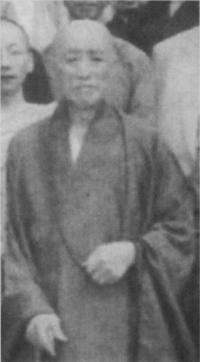Views
Disambiguation Note: Chándìng 禪定 is a term referring to meditative concentration. There also appears to have been a monk with this name who lived much earlier in Nánjīng. See Yuèxiá 月霞.
|
Chándìng 禪定 (1874-19??)
|
| Notable Associates: |
|
Chándìng 禪定 (1874-19??) was a monk associated with the Tiāntái 天台 school and the Guānzōng Lecture Temple 觀宗講寺 in Níngbō 寧波.
Contents |
Biography
Little about the beginning or end of Chǎndìng's life is known. He is said to be from the north of Jiāngsū province, though when and where he was tonsured has gone unrecorded. He served as Guest Prefect 知客 in a temple in Shěnyáng 沈陽 around 1895, and returned to the south around 1910. He became the eldest Dharma Heir 法子 of Yìngqián 應乾, abbot of Liúyún Temple 留雲寺 in Shànghǎi 上海, later taking over as abbot himself.
In 1918 he and Tánxū 倓虛 were classmates at the Guānzōng Study Society 觀宗學社 at Guānzōng Lecture Temple 觀宗講寺 in Níngbō 寧波, which had been established by Dìxián 諦閑. The next year or so Chándìng formally joined the temple and served as head monk 方丈 for about 5 years. He helped with the construction then going on at the temple, and noting that the temple lacked scriptural texts he offered to acquire a set of the canonical scriptures 大藏經 from Běijīng 北京. Dìxián agreed, and Chándìng went to Shànghǎi to prepare for the journey and wait for Tánxū to get leave from the school. In 1920 he and Tánxū traveled together through the north, and arriving in Běijīng successfully solicited 1000 yuán 元 from the warlord Duàn Qíruì 段祺瑞 who ordered that the set of scriptures be printed by the government printers.[1] By the end of 1921 it was ready, and the two monks brought the set back to Níngbō, along with a tablet with an inscription by President of the Republic, Xú Shìchāng 徐世昌, that read "慧日慈雲" (Sun of Wisdom, Clouds of Compassion).[2]
In 1923 Chándìng retired from his position at Guānzōng, later serving at Tàibái 太白 Mountain's Tiāntóng Temple 天童寺 and Léngyán Temple 楞嚴寺 in Yíngkǒu 營口. In 1949 he fled the civil war to Hong Kong 香港 where he stayed at Bǎolián Temple 寶蓮寺 on Mount Xídàyǔ 錫大嶼山. Neither the date of his death nor any details about the final years of his life are known.
Important Works
- Preface to Dīng Fúbǎo 丁福保, Buddhist Studies Collectanea 佛學叢書, August or September, 1920
- This short piece was also printed in Hǎicháoyīn 海潮音, Vol. 2 no. 6, pp. 1-2.
- A few other articles attributed to Chándìng appear in the MFQ and MFQB collections.
Notes
- ↑ Chándìng had prepared an outline of their task (四明觀宗講寺募請藏經疏) and forms for recording donations before he and Tánxū set out.
- ↑ Xú was president of the government in Běijīng, a power contested by the Nationalist Party in Guǎngzhōu, among others.
References
- Fāng Zǔyóu 方祖猷. Tiāntái zōng guānzōng jiǎngsì zhì: 1912-1949 天台宗觀宗講寺志: 1912-1949 (Gazetteer for the Guānzōng Lecture Temple of the Tiāntái School, 1912-1949.) Běijīng: Zōngjiào wénhuà chūbǎnshè, 2006. Pp. 54-55.
- Yú Língbō 于凌波, ed. Xiàndài Fójiào rénwù cídiǎn 現代佛教人物辭典 (A Dictionary of Modern Buddhist Persons), 2 vols. Taipei: Foguang, 2004. Pp. 1666-1667.
